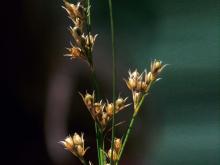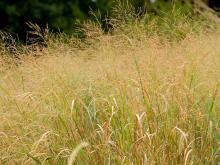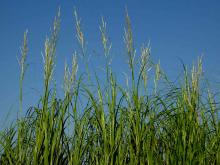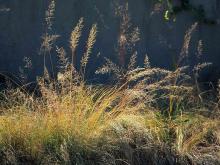Wildflowers, Grasses and Other Nonwoody Plants
Media

Species Types
Scientific Name
Sorghum halepense
Description
Johnson grass is a native of the Mediterranean that is invasive in our country. It’s a weed that infests cropland and degrades native ecosystems, and heavy infestations are found in all the major river bottoms of Missouri.
Media

Species Types
Scientific Name
All true grasses (species in the grass family)
Description
Missouri has 276 species in the grass family, including well-known crop plants and our native prairie grasses. Distinguishing between the species can be difficult, but it’s easy to learn some basics about the group.
Media

Species Types
Scientific Name
Phalaris arundinacea
Description
Reed canary grass is native to Europe, Asia, and North America, and it varies quite a bit. Our native Missouri version, for instance, is quite different from the Eurasian type that has been widely introduced — and which has proven to be highly invasive.
Media

Species Types
Scientific Name
Juncus spp. and Luzula spp.
Description
Missouri has 24 species in the rush family. Distinguishing between these grasslike plants can be tricky, but it’s easy to learn some basics about the group.
Media

Species Types
Scientific Name
Carex, Schoenoplectus, Scirpus, and other genera
Description
Missouri has more than 200 species in the sedge family. Distinguishing between these grasslike plants can be difficult, but it’s easy to learn some basics about the group.
Media

Species Types
Scientific Name
Panicum virgatum
Description
Switchgrass is a native perennial, warm-season, clump-forming mid or tall grass. In midsummer, delicate-looking, open, multiply-branching flowering clusters rise above the foliage.
Media

Species Types
Scientific Name
Spartina pectinata
Description
Prairie cordgrass is a native perennial sod-forming grass with flowering stalks up to 7 feet tall. A grassland species, it grows in dense stands in low, damp soils. It’s often called ripgut because of the tiny sharp saw teeth on the leaf edges.
Media

Species Types
Scientific Name
Sporobolus heterolepis
Description
Prairie dropseed is a native perennial bunch grass that forms dense clumps of fine, light green, arching leaves. The seed heads are airy, open, branching clusters bearing small, ovate florets on their own individual branchlets.
Media

Species Types
Scientific Name
Festuca arundinacea
Description
You’ve seen it a million times, now learn to identify it! Technically an exotic invasive plant, tall fescue is practically everywhere, from lawns to levees, and from pastures to (unfortunately!) prairies.
Media

Species Types
Scientific Name
Acorus calamus (syn. A. calamus var. calamus)
Description
At a glance, the upright sword-shaped leaves of sweet flag make it resemble cattails. Like them, sweet flag lives in wet soils. But the flower heads are distinctive, and details of the leaves set them apart, too.
See Also
About Wildflowers, Grasses and Other Nonwoody Plants in Missouri
A very simple way of thinking about the green world is to divide the vascular plants into two groups: woody and nonwoody (or herbaceous). But this is an artificial division; many plant families include some species that are woody and some that are not. The diversity of nonwoody vascular plants is staggering! Think of all the ferns, grasses, sedges, lilies, peas, sunflowers, nightshades, milkweeds, mustards, mints, and mallows — weeds and wildflowers — and many more!





















